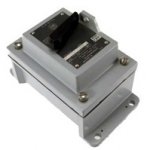RogerD
Member
- Location
- Greenville, SC
Need some help,
I've got a bleacher system in a high school that has 5 - 1/2 HP motors with name plate ratings of 115V / 6.2A and are not thermally protected. The Manufacturers recommendation is a single circuit with a 40A circuit breaker.
I'll admit it's been sometime that I've had to address code issues so I might be mistaken so some input would be appreciated.
Article 430.33 states;
"A motor used for a condition of service that is inherently short-time, intermittent, periodic, or varying duty, as illustrated by Table 430.22 (E), shall be permitted to be protected against overload by the branch-circuit short-circuit and ground-fault protective device, provided the protective device rating or setting does not exceed that specified in Table 430.52.
Any motor application shall be considered to be for continuous duty unless the nature of the apparatus at drives is such that the motor cannot operate continuously with load under any condition of use".
The bleachers take about 15 seconds to fully extend and rest at a minimum of 2 hrs. so each motor could be classified as a short time or intermittent motor. My question is can this article be applied to a multi-motor circuit?
I've got a bleacher system in a high school that has 5 - 1/2 HP motors with name plate ratings of 115V / 6.2A and are not thermally protected. The Manufacturers recommendation is a single circuit with a 40A circuit breaker.
I'll admit it's been sometime that I've had to address code issues so I might be mistaken so some input would be appreciated.
Article 430.33 states;
"A motor used for a condition of service that is inherently short-time, intermittent, periodic, or varying duty, as illustrated by Table 430.22 (E), shall be permitted to be protected against overload by the branch-circuit short-circuit and ground-fault protective device, provided the protective device rating or setting does not exceed that specified in Table 430.52.
Any motor application shall be considered to be for continuous duty unless the nature of the apparatus at drives is such that the motor cannot operate continuously with load under any condition of use".
The bleachers take about 15 seconds to fully extend and rest at a minimum of 2 hrs. so each motor could be classified as a short time or intermittent motor. My question is can this article be applied to a multi-motor circuit?

